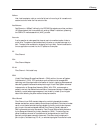
Synchronous
Synchronous communications occurs when the transmission of data between two
devices is synchronized with a clocking scheme or other technique. The sender and
receiver need to synchronize with one another before data is sent. In synchronous
communication the bit stream and the clock pulse are synchronized by a special bit
transition pattern in the digital signal creating an exactly timed stream of bits from the
sending device to the receiving device. An example of such a mechanism is bipolar
encoding. Synchronous communication is either character or bit oriented. Character
oriented synchronous transmissions are used to send blocks of characters such as found
in ASCII (American Standard Code for Information Interchange) files. Bit oriented
synchronous communication is used primarily for the transmission of binary data.
See also Asynchronous, ASCII, Binary and EBCDIC, HRC, HORC.
Tach
Abbreviation for Tachyon Fibre Channel interface.
TB
A Terabyte (TB) equals 1000 Gigabytes. Some vendors today define a terabyte
as 1024 GB, causing confusion in the industry.
TCP
Transmission Control Protocol or TCP is a transport layer component of the Internet’s
TCP/IP protocol suite. It sits above IP in the protocol stack and provides reliable data
delivery services over connection-oriented links. TCP uses IP to deliver information
across a network and makes up for the deficiency of IP providing a guarantee of
reliable delivery services that IP does not. TCP messages and data are encapsulated
into IP datagrams and IP delivers them across the network.
VERITAS
®
A Mountain View, California software company that develops and supports volume
and file management software products for a variety of Unix
®
and Windows
®
platforms.
Virtual Logical Volume Image Manager
Virtual Logical Volume Image Manager (VLVI) is a software utility in the Resource
Manager 7000/9000
™
that allows for configuration of RAID configurations, create,
delete, verify, rebuild, tune, and abort operations. See also RAID and the Freedom
9000 Resource Manager 7000/9000
™
.
Volume
An ESA/390
®
term for the information recorded on a single disk unit or recording
medium. Indirectly, a volume can refer to the unit of recording medium itself. On a
non-removable medium storage device such as a disk drive, the terms may also refer,
indirectly, to the storage device that is associated with the volume. When a user stores
multiple volumes on a single storage medium transparent to the program, the volumes
are referred to as logical volumes.
69
Glossary


















